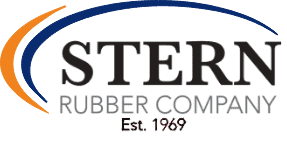After our new addition was completed, where we added about 12,000 square feet to the main building (plant number one), the first department to take advantage of the extra room was our cryogenic deflashing and rubber trimming departments. We created a space on the first floor that houses a room for the trimming and inspection department. We moved our two cryogenic deflashing units to the north wall and move the 6,000 gallon liquid nitrogen tank to the outside of the south wall.
Since 1969, Stern Rubber Company has been molding custom rubber products and rubber extrusions at three locations in Minnesota. When we mold parts for production, we precisely weigh out our raw rubber before we mold our products on the compression and transfer molds; we make sure that only a small amount of flash is created around the rubber parts so that we guarantee that we don’t have under filled parts, which would render our parts unacceptable by our customers. In our rubber injection presses this is governed by computer, so that they too only leave a small amount of rubber flash on each part. Rubber flash is the material the oozes between the seams of the top and bottom portion of the molds and is usually about 1 micron thick. Removing this flash from the parts is necessary and we employ two applications for its removal: freezing the part in our cryogenic deflashing units or hand trimming of the part.
Cryogenic deflashing is taking rubber parts and putting them in a basket or a moving conveyor inside the cryogenic unit. Shutting or closing the unit’s door and injecting liquid nitrogen to freeze the flash only, the rubber parts don’t freeze and we use a large amount of small plastic beads driven by air to pulverize the rubber flash from the rubber parts. The rubber flash become brittle at an approx. temperature of -40⁰F, which allows the rubber to breakaway freely from the rubber parts, rendering 99% of the flash is removed. The liquid nitrogen can actually get as low as -275⁰F, but we would never want to get rubber parts that cold, as it would simply break them into tiny pieces during the tumbling process. In many of our applications ninety-nine percent is acceptable since it is not seen as a cosmetic application.
In our hand trimming department, removing 100% of the flash is necessary and each part is trimmed by a skilled trimmer who handles each part using a lighted magnifying lens or light to insure the parts are free of rubber flash. This process adds cost to the part price since this is a labor intensive and time consuming activity, but is necessary in order to create a high quality rubber part. Some of our parts are tiny in size and requires delicate and very precise trimming, while other parts are larger, but still have similar needs in trimming, it is just easier too clear away the rubber flash.
Once the molded rubber products are cleaned of the rubber flash, they are cleared to be shipped to our customers. This is why we moved our trimming and deflashing department into our new addition, closer to the shipping department as it improves our flow of product. With the increased space, we also added more warehouse room.
